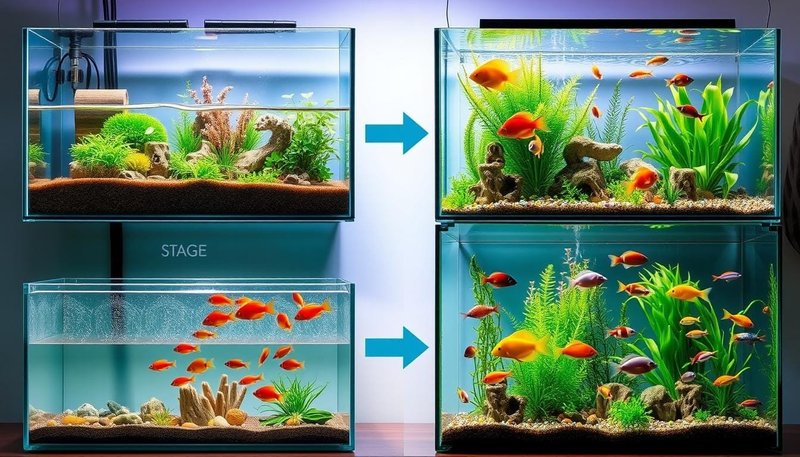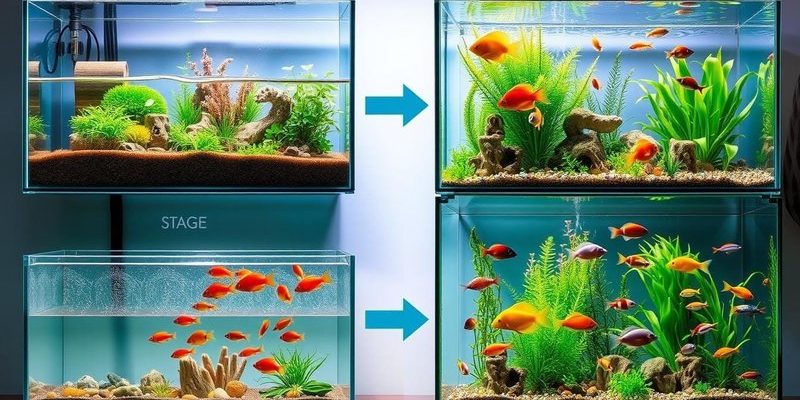
You might think of cycling as a kind of boot camp for your tank. Just like how humans need time to adjust and build up strength before running a marathon, your tank needs time to develop a balanced ecosystem. Doing it right means a smoother ride for both you and your fish. Let’s dive into how to cycle a freshwater tank properly, ensuring your aquatic buddies get the best start possible.
What Is Tank Cycling?
Tank cycling refers to the process of establishing beneficial bacteria in your aquarium. These bacteria help convert toxic ammonia from fish waste into harmless nitrates, creating a balanced environment. Honestly, think of it as building a small community in your tank—where everyone has a role to play. The key players here are beneficial bacteria, which break down waste products and keep your water healthy.
You might be wondering how long this takes. Typically, cycling can take anywhere from 4 to 6 weeks. During this time, your tank goes through several stages: the initial buildup of ammonia, the growth of nitrifying bacteria, and finally, the conversion of ammonia to nitrite and then to nitrate. This process is vital because, without it, you could end up with a tank that’s toxic to fish.
In the next sections, we’ll break down the steps you need to take to cycle your freshwater tank.
Step 1: Set Up Your Tank
Before you even think about cycling, you’ll need to set up your tank. This includes adding substrate, decorations, and equipment like filters and heaters. Think of this stage as preparing the stage for a play. You want everything in place before the show starts.
Choosing the Right Substrate
The substrate is the material that lines the bottom of your tank. It can be gravel, sand, or specialized plant soil. If you plan on having live plants, consider using a nutrient-rich substrate that will support healthy plant growth. On the other hand, if your focus is mainly on fish, regular aquarium gravel will do just fine.
Setting Up the Filter
An aquarium filter is crucial for cycling because it’s where a lot of beneficial bacteria will grow. You can choose between hang-on-back (HOB), canister filters, or sponge filters, depending on your tank size and the type of fish you plan to keep. Make sure to install the filter before you fill your tank with water so that it can start working right away.
Step 2: Adding Water and Dechlorination
Once your setup is complete, it’s time to fill your tank with water. But hold on a minute! You need to make sure the water is safe for your fish. Tap water often contains chlorine, which can harm your beneficial bacteria.
Dechlorinating Your Water
To remove chlorine, you can use a dechlorinator that you can find in any pet store. Just follow the instructions on the bottle for the right dosage. If you’re planning to use the water without dechlorination, let it sit for 24 to 48 hours to allow the chlorine to evaporate naturally. Remember, this step is essential for creating a safe environment for the bacteria that will soon call your tank home.
Step 3: Choosing a Cycling Method
When it comes to cycling your tank, you have a couple of options. The two most popular methods are fishless cycling and fish-in cycling. Let’s break them down.
Fishless Cycling
This method is generally more humane and allows you to create the right conditions without putting any fish at risk. You essentially add ammonia to the tank to feed the beneficial bacteria. It might sound odd, but you can use pure ammonia from a hardware store (make sure there are no additives) or drops of fish food to kickstart this process.
1. Add ammonia to your tank until you reach a concentration of about 2-4 ppm (parts per million).
2. Test your water regularly for ammonia, nitrite, and nitrate. Once you see ammonia drop to 0 ppm and a rise in nitrite, you’re on the right track!
Fish-In Cycling
If you already have fish in your tank and need to cycle it, you’ll need to do this more carefully. Start with a small number of fish to avoid overwhelming your tank. The goal here is to keep the ammonia levels as low as possible. Regular water changes of about 10-20% will help manage ammonia levels until the cycle completes.
Pro Tip: Always monitor your fish closely for signs of distress, such as gasping at the surface or unusual swimming patterns. If your fish seem stressed, it’s best to do a water change immediately.
Step 4: Monitoring Water Parameters
Regularly testing your water parameters is key during the cycling process. You’ll want to keep track of three main levels: ammonia, nitrite, and nitrate. Each tells you something different about how your cycle is progressing.
Ammonia Levels
Ammonia should start at a level you put in (if fishless cycling) or close to zero (if fish-in cycling). As beneficial bacteria grow, you’ll see these numbers drop. If ammonia levels don’t decrease over time, it could mean that your cycling isn’t progressing properly.
Nitrite and Nitrate Levels
Once ammonia hits zero, nitrite levels will begin to spike. This is actually a good sign! Eventually, you’ll notice that nitrites drop to zero too, and nitrates start to rise. Nitrates are less harmful and can be managed through regular water changes.
Step 5: Establishing a Routine
Now that your tank is cycled, it’s important to establish a maintenance routine. This will help keep everything balanced and your fish healthy.
Regular Water Changes
Aim for 10-20% water changes weekly. This will help manage nitrate levels and keep your tank looking clean. Don’t forget to always use a dechlorinator when filling your tank after a water change.
Monitoring Fish Health
Keep an eye on your fish for any signs of stress or illness. A healthy fish will have bright colors, normal behavior, and eat well. If you notice any changes, check your water parameters immediately.
Cycling a freshwater tank properly is the backbone of successful fishkeeping. Whether you choose fishless cycling or fish-in cycling, taking the time to establish beneficial bacteria will pay off in the long run. Remember, this process isn’t just about numbers; it’s about creating a healthy home for your aquatic friends.
So, as you embark on your journey, take it step by step. Enjoy watching your tank transform, and rest easy knowing you’re setting the stage for a thriving underwater community. With a little patience and care, you’ll soon have a vibrant tank that you and your fish can enjoy for years to come. Happy fishkeeping!

